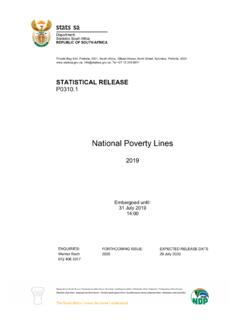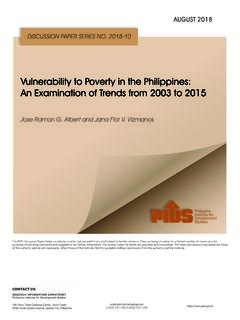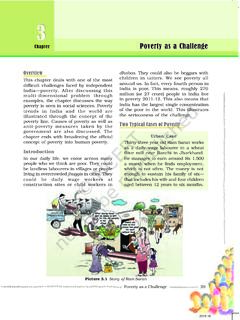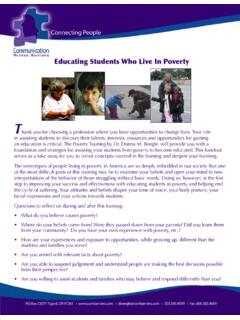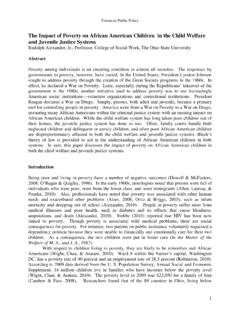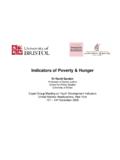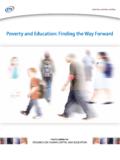Transcription of POVERTY BRIEF – UNDERSTANDING POVERTY
1 Multidimensional povertyThe idea that POVERTY is multidimensional was first pre-sented by Townsend (Townsend, 1979) and further developed by Chambers (Chambers, 1983). In the final declaration of the World Summit for Social Develop-ment in 1995, the United Nations concluded that: POVERTY has various manifestations, including lack of in-come and productive resources sufficient to ensure sus-tainable livelihoods; hunger and malnutrition; ill health; limited or lack of access to education and other basic services; increased morbidity and mortality from illness; homelessness and inadequate housing; unsafe environ-ments; and social discrimination and exclusion. It is also characterized by a lack of participation in decision-mak-ing and in civil, social and cultural life. (United Nations, 1995)This description stresses the multidimensionality of pov-erty.
2 It combines notions of absolute and relative pover-ty and points to the need to differentiate poor people by gender, age, occupational status, origin or ethnicity. In 2001, the Development Assistance Committee (DAC) of the Organization for Economic Co-operation and De-velopment (OECD) published its Guidelines for POVERTY Reduction (OECD, 2001) and adopted a multi-dimen-sional POVERTY definition: What is POVERTY Definitions of POVERTY really matter. They set the stand-ards by which we determine whether the incomes and living conditions of the poorest in society are accept-able or not. Definitions of POVERTY are also important, as they influence the way interventions and policies ad-dressing POVERTY are shaped. Despite this, there is am-biguity as to how the term POVERTY is used and as a result, a range of definitions exists, influenced by differ-ent disciplinary approaches, world views and ideologies (Handley et al.)
3 , 2009). Historically, POVERTY has been defined in monetary terms, using income or consumption levels. In order to be able to compare POVERTY levels across countries and over time, those that live below a given level of income the POVERTY line (Ravallion, 2010) are classified as poor. Over the last decades, this economic definition of POVERTY has been complemented by other approaches to conceptualise POVERTY : basic needs approach, capa-bilities approach, human development approach and multidimensional POVERTY approach (Handley et al., 2009).Chambers (2006), a leading scholar on POVERTY and de-velopment, clusters POVERTY definitions into four groups: Income POVERTY (or its common proxy, consumption POVERTY ). Material lack or want: besides income, this includes absent, limited or low quality assets (such as shel-ter, clothing, furniture, personal means of transport, radio, etc.
4 It also includes inadequate access to services. Capability deprivation, referring to what people can or cannot do, or can or cannot be. This goes well beyond material lack to include human capabilities, such as skills and physical abilities, and also self- respect in society. Multidimensional deprivation, with material lack or want, as only one of several mutually reinforcing BRIEF UNDERSTANDING POVERTY EVA LUDI, ODIA bsolute and relative PovertyAbsolute POVERTY : when people lack basic neces-sities for survival. It quantifies the number of peo-ple below the POVERTY line and is independent of place and time. Relative POVERTY : when people s way of life and income is much worse than the general standard of living. It classifies people as poor not by comparing them with a fixed POVERTY line, but by comparing them with others in the population under BRIEF UNDERSTANDING Poverty1 Visit the SharewebPOVERTY | and animals, forests and fishing waters, credit and decent employment.
5 Human capabilities are building on having access to health, education, nutrition, clean water and shel-ter. Lacking access to these services can mean dis-ease and illiteracy, which are barriers to productive work, and thus to economic capabilities for POVERTY reduction. Reading and writing support communica-tion, which is crucial in social and political participa-tion. Education, especially for girls, is key to POVERTY reduction. Political capabilities include having human rights and a voice in debates on public policies and polit-ical priorities. Deprivation of political freedoms or human rights, as well as arbitrary, unjust and violent action by public authorities, can be a major driver of POVERTY . Socio-cultural capabilities relate to participation as a valued member of a community and include social status, dignity and other cultural conditions.
6 Geographic and social isolation is a major dimension of POVERTY in many societies. Protective capabilities enable people to withstand seasonal variations and external shocks and prevent-ing POVERTY . Insecurity and vulnerability are strongly related to POVERTY with links to all other dimensions. POVERTY encompasses different dimensions of depri-vation that relate to human capabilities including con-sumption and food security, health, education, rights, voice, security, dignity and decent work. POVERTY must be reduced in the context of environmental sustainabil-ity. Reducing gender inequality is key to all dimensions of POVERTY . (OECD, 2001)The DAC recognises that POVERTY is defined in various ways, but suggests that POVERTY definitions should be context-specific and should encompass the key dep-rivations faced by poor women and men and identify the ways in which they are incapacitated (Figure 1).
7 The DAC has adopted the capabilities approach to POVERTY (see below) and suggests that POVERTY outcomes are af-fected by individual and household capabilities and that these capabilities are interrelated. However, the DAC emphasises that distinguishing between capabilities is important both for analysis and in order to design ef-fective policies and DAC outlines the following 5 capabilities / dimen-sions (OECD, 2001): Economic capabilities, the ability to earn an income, to consume and to have assets. These are the foundations for food security, material wellbe-ing and social status, and poor people often identify them as priorities, along with secure access to land, PROTECTIVEC apabilities, enabling people to withstand Economic shocks Natural Disasters ConflictsPOLITICALC apabilities, including Human rights Voice Political freedom ParticipationECONOMICC apabilities to earn income to consume to have assetsHUMANC apabilities, based on Health Education Nutrition ShelterSOCIO-CULTURALC apabilities concerning Dignity Valued membership of society Social statusFigure 1: OECD s Multidimensional POVERTY Framework(Source.)
8 OECD, The DAC Guidelines POVERTY Reduction, 2001) POVERTY BRIEF UNDERSTANDING Poverty2 POVERTY Definitions and MeasurementsIncome povertyAbsolute definitions of POVERTY are based on income (or consumption) in relation to a specific living standard or minimum income level deemed necessary to meet basic needs . In 1990, the extreme POVERTY line for devel-oping countries was set at US$1 per person and day. The US$1-a-day threshold was adjusted in 2008 and in-creased to US$ , and in October 2015 to US$ to reflect the actual national POVERTY lines in the 15 poor-est countries (PovcalNet The World Bank). Impressive gains have been made in reducing extreme POVERTY . The MDG target of halving the proportion of people living below the US$ extreme POVERTY line has been reached five years ahead of the 2015 dead-line. Nevertheless, global figures mask stark differences within and across countries (OECD, 2013).
9 In September 2015, the UN General Assembly adopted the 17 Sustainable Development Goals (SDGs) and 169 associated Targets. Goal 1 is concerned with ending POVERTY in all its forms everywhere. Target aims at eradicating extreme POVERTY , measured as living on less than US$ a day, by 2030 for all people. It also calls for reducing at least by half the proportion of people living in POVERTY in all its dimensions according to na-tional definitions (target ) (United Nations, 2015).Basic needs approachBasic needs are defined as minimum quantities of such things as food, clothing, shelter, water and sanitation, access to basic education and health services and secu-rity to prevent ill health, undernourishment, or under- and unemployment (Streeten et al. 1981). It is based on a broader UNDERSTANDING of well-being and includes access to different goods and services and related achievements, such as adequate nutrition, life expec-tancy, mortality, etc.
10 (Shaffer, 2008). Despite a common POVERTY line used across countries to compare POVERTY rates, it was always recognised that what is required to satisfy basic needs will vary greatly across different countries. Countries, therefore, often use several national POVERTY lines based on the cost of basic needs (CBN) approach including a lower pover-ty line which monetises the minimum calories required to maintain life and an upper POVERTY line which also includes a basic basket of goods and services deemed necessary for a healthy life, including basic costs for clothing, shelter and accessing education and health. Capabilities approachIncome and basic needs approaches look at inputs rath-er than outcomes . Knowing the level of a household s income does not tell us anything about the well-being of this household. The capabilities approach, based on work by Sen and Nussbaum (Nussbaum & Sen, 1993; Nussbaum, 2000; Sen, 1985, 1999), describes pover-ty as a denial of choices and opportunities for living a tolerable life (Lister, 2004).

